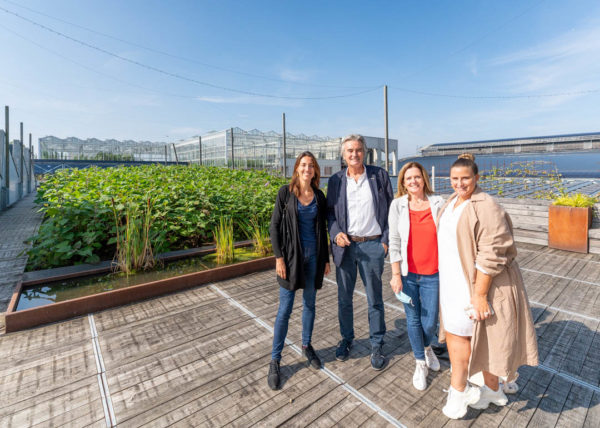
BIGH: Brussels’ aquaponics is conquering Europe
When you dream, dream big. BIGH is an innovative, 100% circular project from architect Steven Beckers. It’s also the largest aquaponics farm in Europe. No less. And his fish are on the move. Sitting on top of the Anderlecht slaughterhouse (Abattoirs d’Anderlecht) they are already planning their migration to France and Europe, notably via Brussels Days in Paris. Story of a life-sized utopia.
“Aquaponics demonstrates the symbiosis of nature with the city.”
Hello Steven! Today, you’re taking us behind the scenes of the BIGH project. But, tell us, what exactly is aquaponics?
Steven Beckers: Aquaponics is the combination of hydroponics, which is above ground soilless farming, with recirculating aquaculture, a water saving fish and seafood production method.
The benefit of aquaponics is that it converts aquaculture waste into nutrients for horticulture. The fish waste is treated in our biofilter and the enriched water is fed to the plants in the greenhouses, so we can reduce fish farming waste and use almost no other fertiliser for our vegetables!
BIGH is therefore a 2,000 m² hi-tech greenhouse and a 2,000 m² outdoor vegetable garden, at the heart of Brussels, on the roof of the Foodmet market.
You are an architect. How did the BIGH project come about?
The roots of the BIGH project are found in the search for economically viable solutions to make the real estate and environment of urban areas productive, circular and regenerative.
I came up with the concept, but I quickly surrounded myself with specialists to implement it. The first investors came very quickly. Veolia joined in and provided the project with management, growth and financial resources.

Fish and vegetables to complete the circular loop
What role do aquaponics have to play in the future?
Just as permaculture has become a way of thinking for companies, aquaponics demonstrates the symbiosis of nature with the city, carried out without pollution while providing many positive and virtuous social, economic and environmental impacts.
Aquaponics is a fascinating topic because of its natural circularity. A great many players have to be brought together for this type of complete project. BIGH means Building Integrated GreenHouses, as well as BIGH Impact and, why not, BIGH Company very soon…? While maintaining the ethics intrinsic to the company!
Is it possible to be profitable AND circular?
In theory, everything circular must be profitable in the long run, based on the positive and regenerative impact of the concept. The ways to calculate profitability must also be adapted and take certain externalities into account. BIGH is in the process of proving that it can be profitable, despite the many pitfalls it has to overcome. It’s a matter of scale and market response.
BIGH, soon an adventure abroad too
Can BIGH be rolled out in all of the world’s big cities?
Yes, very much so. The goal of a farm like BIGH is to produce for the city in the city using the resources available (waste heat, solar energy, rain water, etc.). The food production (fish species, different varieties of fruits and vegetables) has to be adapted, but the model can be used everywhere. The BIGH project is ambitious and intends to provide an answer to the food issue in 2050.
You are attending the Brussels Days 2021 in Paris. What opportunities are available in the French market?
We’re studying opportunities in France. Our partner Veolia is a global and French major. The credibility of the collaboration and its network make France a leading prospect. In addition, our eating habits are similar and Belgium is often used as a test market for new French products.
And what are BIGH’s international plans?
We have applied to the European Union’s Horizon 2020 Call for Projects, launched as part of the Green Deal. The goal is to fund projects which will meet the climate and environmental challenges we are facing.
We’ve been included as a partner in the PHOTONFOOD Horizon 2020 project, which is intended to develop a flexible, accessible and easy-to-use tool to detect the presence of, and/or analyse, mycotoxin concentrations in food production.
Large quantities of cereals and/or nuts are thrown out every year in Europe due to excessively high mycotoxin concentrations. Faster detection will ensure greater prevention. The moulds are responsible for 5% of production losses at BIGH.

Brussels as a springboard
BIGH was born in Brussels; is this a coincidence?
No, rather an obvious choice: the Brussels-Capital Region is very dynamic in terms of circularity and improving its existing assets. The Foodmet at the slaughterhouse (at the heart of Brussels) is a perfect example with 4,000m2 of roof space. Brussels is also the capital of Europe and an attractive platform for visitors from around the world. The Region has also invested in BIGH, via finance&invest.brussels, and is encouraging banks to follow our private investors, after several assessment rounds.
We also received support from hub.brussels. As BIGH was participating for the first time in a European project, we had a lot of questions; through its National Contact Point and Enterprise Europe Network services, hub.brussels provided us with advice, information and solid support. This helped us to better understand the challenges of such European projects.
A word for the entrepreneurs in your sector?
Innovation is always an obstacle course and, sometimes, the best ideas are dropped due to lack of support. The current period is favourable for paradigm shifts and new models. Added value can be generated by a systemic approach.
Are you like Steven and want to develop a sustainable project and take it beyond our borders? Find out about our services!
Vous souhaitez développer votre entreprise? Et pourquoi ne pas vous lancer à l’export? Distribuez vos produits et services sur de nouveaux marchés, en Europe et dans le reste du monde, avec hub.brussels!
Vous avez un projet innovant et êtes en recherche de financement ou d’un réseau pour l’exploiter au-delà des frontières? L’équipe National Contact Point (NCP) Brussels vous accompagne!